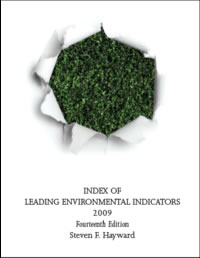San Francisco – The Pacific Research Institute (PRI) and the American Enterprise Institute (AEI) released the 2009 Index of Leading Environmental Indicators, an annual report highlighting the significant environmental developments and milestones in the United States and worldwide. The 2009 edition marks the anniversary of key moments in environmental history, including the 1989 Exxon Valdez tanker disaster, the 1969 Santa Barbara oil spill, and perhaps the most iconic event in environmental history — the Cuyahoga River fire of June 1969.
“The recovery of the ecosystems of both the Cuyahoga River and Prince William Sound has been nothing short of remarkable, though it seldom gets much attention in the media or from environmentalists,” said Steven F. Hayward, author of the Index, and a senior fellow at PRI and the F.K. Weyerhaeuser Fellow at AEI. “However, some more diffuse or wide-scale problems, such as the restoration of the Florida Everglades, remain mired in bureaucracy or opaque from a lack of reliable data, with little progress being made.”
Other important news of environmental progress from the last year includes:
- Growing evidence that the tropical rainforests may now be expanding faster than they are being cut down, though more data are needed to determine the nature and extent of reforestation trends.
- The world’s most severe environmental problems, as ranked by the Blacksmith Institute and Green Cross Switzerland, are overwhelmingly problems of poverty in developing nations. No American or Western European city ranks among the top 50 cities in the world for air pollution in a World Bank ranking.
- The U.S. Geological Survey sampling of drinking water drawn from surface waters in 17 areas around the continental United States found very low (non-hazardous) or no presence of 258 different man-made chemicals.
- Air pollution levels are falling in the 10 most polluted cities in the U.S., by as much as 27 percent over the last decade in the case of fine particulates in Los Angeles.
- Stratospheric ozone — the “good” kind of ozone, akin to “good cholesterol in blood — appears to have reversed its long-term decline and is now increasing over the U.S. The level of ozone-destroying chemical compounds in the atmosphere declined 12 percent from 1995 through 2006.
- U.S. carbon emissions rose 76 million tons in 2007 (the most recent year for which data are available), after having fallen 81 million tons in 2006. Most of this increase was attributable to colder weather in the winter of 2007.
“Public opinion data on advertising and marketing suggest growing public weariness with ‘green’ messages in general and messages on global warming in particular,” Dr. Hayward said. “It’s no wonder. The data show that 2008 was the coolest year since 2000, and there has been no discernible warming for the last decade, after two decades of steady warming between 1979 and 1998.”


